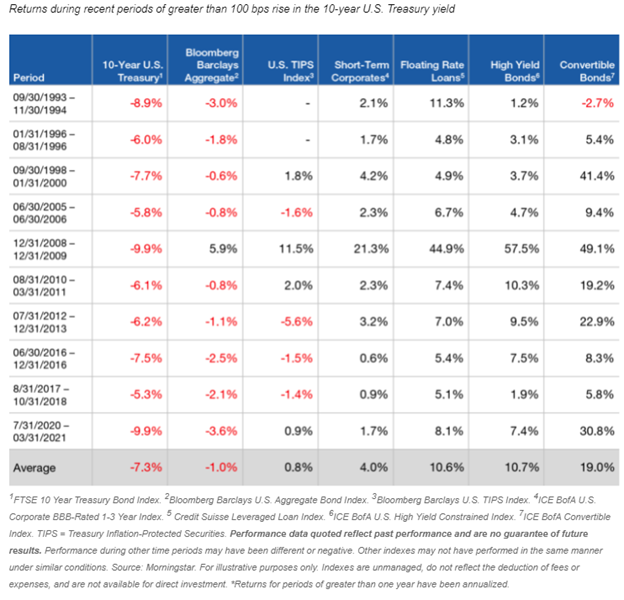
(Kostya Etus, CFA®, Head of Strategy, Dynamic Investment Management) A top theme in 2022 is the rising interest rate environment, coming off historically low levels. The expectations for rising rates stem from three components: high inflation, Federal Reserve (Fed) bond tapering and the Fed raising the short-term interest rate target range.
The most important things to do during periods of market uncertainty are to stay invested for the long term (don’t attempt to time the market) and properly diversify your investment portfolio. Here’s how to best diversify for a rising rate environment:
Key Takeaways
- Diversify, diversify, diversify. That’s the name of the game.
- To help lower portfolio risk and potentially increase returns over the long term, diversify within the equity and fixed income portions of your portfolio into asset classes that are more resilient to a rising rate environment.
- Diversification beyond stocks and bonds into uncorrelated alternative assets classes can further dampen overall volatility, provide sources of income and offer potential for a smoother return stream.
Diversify Your Bonds
Some of the hardest hit areas during a rising rate environment are the more traditional, high quality, longer duration bonds (see chart below). The longer the duration and the higher the quality (typically associated with lower yield), the more interest rate sensitivity there is. Here are a few ways that some of this risk can be diversified within your bond allocation:
1. Lower Duration: Simply allocating to shorter duration bonds can help dampen interest rate risk. Keep in mind, lower duration is typically associated with lower yield, all else equal.
2. Increase Yield: To help support some of the yield lost from lowering duration, you can allocate to lower credit quality bonds, often referred to as high yield bonds (typically bonds issued by corporations as opposed to government bonds). These bonds tend to be more volatile, but their increased yield can help support your income needs while diversifying interest rate sensitivity.
3. Allocate to Various Fixed Income Asset Classes: Similar to equities, there are various bond sectors with different characteristics to which you can allocate to help diversify interest rate risk. A few common allocations include:
- Floating Rate Loans: As the name implies, these fixed income securities appreciate in value as interest rates rise and can often offer competitive yields, helping to mitigate rate risk.
- Treasury Inflation-Protected Securities (TIPS): These securities have a principal value which is indexed to the rate of inflation. This helps diversify their return stream from traditional bonds, particularly during higher inflation environments. However, keep in mind that TIPS may have higher duration and still be subject to rising interest rate risk headwinds (note their relatively weak performance in the chart below).
- Convertible Bonds: Another unique corporate debt security, these bonds yield interest, but are able to be converted to a predetermined number of stock shares of the issuing company. These securities share both the growth characteristics of stock investments and some of the defensive properties of bonds.
Returns of Various Fixed Income Asset Classes During Periods of Rising Rates
 Diversity Your Stocks
Diversity Your Stocks
Just like with bonds, some stocks can be more impacted by a rising interest rate environment than others. The chart below depicts which industries may perform best (and worst) given different interest rate and inflation scenarios. It’s always prudent to be diversified amongst style and size within equities. That said, there are some common characteristics between the companies that perform best during a rising rate environment:
- Cyclical Stocks: These tend to be more value-oriented companies such as those in the financials sector (banks, insurance, etc.). A rising interest rate environment in combination with higher inflation will often steepen the yield curve—allowing financial institutions to borrow at low rates and lend out at higher rates—widening profit margins.
- Inflation-Sensitive Stocks: Companies within the energy and materials sectors are able to both pass on rising costs and benefit when prices are rising. Additionally, while rising interest rates may pose challenges for higher dividend-yielding sectors such as real estate, economic growth (which often accompanies rising rates and inflation) translates into higher real estate demand.
- Higher Quality Stocks: Companies with strong brand presence, monopolistic pricing power and higher profit margins, such as those in the healthcare sector, are better able to weather a variety of market conditions. These companies may be better able to navigate any market or economic volatility exhibited from a rising interest rate environment.
Sensitivity of Industry Groups to Inflation and Interest Rates
Diversify Your Stocks and Bonds
There are additional asset classes which can not only help diversify your portfolio from stock market risk, but can also help diversify some of the interest rate risk inherent in bonds. These are typically classified as alternative investments and come in a variety of flavors. But one thing that unifies them: They tend to be less correlated with both stocks and bonds (as the graphic below shows). Alternative investments can be classified into three categories:
1. Liquid Alternative Strategies: These are publicly available funds which typically utilize strategies from private investments such as hedge funds. Common strategies include:
- Market Neutral: Attempt to profit regardless of an upward or downward market environment, often utilizing long/short strategies and derivatives.
- Arbitrage: Attempt to take advantage of mispricing in the market. The most common strategy is “merger arbitrage” which includes purchasing a company being acquired and shorting the company making the acquisition.
- Managed Futures: Allocate to futures contracts in a variety of asset classes to benefit from shifting economic, market and political conditions.
2. Global Real Estate: This is a distinct, less correlated asset class because the underlying investments differ in structure from typical stocks and bonds (often investing in commercial real estate properties). These cash flow heavy investments allow for higher and more consistent dividend income, which can help supplement income needs in the absence of bond allocations. Infrastructure is often considered a subset of real estate, but offers its own unique attributes.
3. Commodities: There are multiple components within this asset class, however the two primary ones are commodity futures (such as oil, gold and corn) and companies that produce or harvest natural resources (such as gold miners). One of the primary benefits of these investments is their high sensitivity to inflation, making them a potential inflation hedge.
Correlations Between Stocks, Bonds, and Various Alternative Asset Classes
 Source: Morningstar Direct, 15-year monthly data: 02/01/2007 – 01/31/2022
Source: Morningstar Direct, 15-year monthly data: 02/01/2007 – 01/31/2022
As we welcome 2022 and the potential for a rising interest rate environment, remember the three key takeaways: Diversify, Diversify, Diversify. 1) Diversify interest rate risk within bonds with various fixed income asset classes, 2) diversify among various styles of stocks and 3) diversify stock and bond risk with alternatives to help provide a more consistent return stream for years to come (regardless of market environment). That in turn can improve the chances of staying invested—and staying the course of reaching long-term investment goals.





